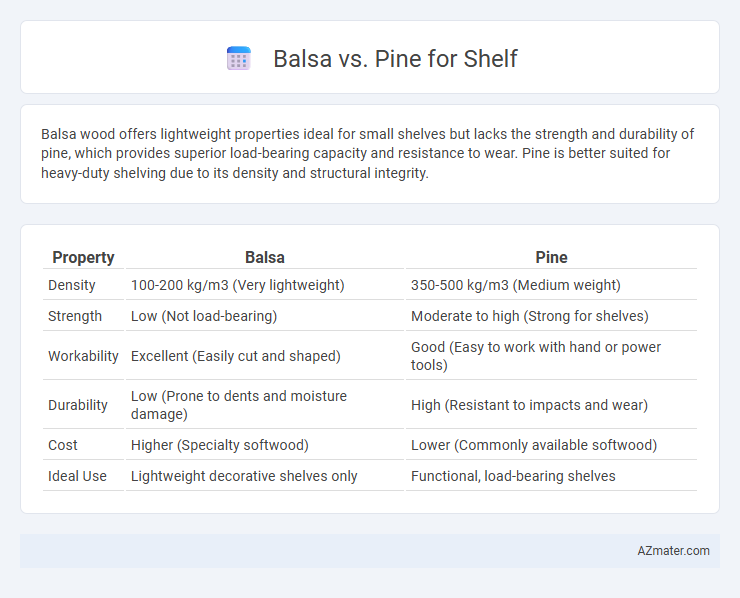Balsa wood offers lightweight properties ideal for small shelves but lacks the strength and durability of pine, which provides superior load-bearing capacity and resistance to wear. Pine is better suited for heavy-duty shelving due to its density and structural integrity.
Table of Comparison
| Property | Balsa | Pine |
|---|---|---|
| Density | 100-200 kg/m3 (Very lightweight) | 350-500 kg/m3 (Medium weight) |
| Strength | Low (Not load-bearing) | Moderate to high (Strong for shelves) |
| Workability | Excellent (Easily cut and shaped) | Good (Easy to work with hand or power tools) |
| Durability | Low (Prone to dents and moisture damage) | High (Resistant to impacts and wear) |
| Cost | Higher (Specialty softwood) | Lower (Commonly available softwood) |
| Ideal Use | Lightweight decorative shelves only | Functional, load-bearing shelves |
Introduction to Balsa and Pine Wood
Balsa wood, renowned for its exceptional lightness and softness, is prized in applications where weight reduction is critical, such as model building and crafts, but it lacks the hardness needed for structural shelves. Pine wood, a softwood with moderate density and natural resin content, offers greater strength and durability, making it a popular choice for robust shelving solutions. Understanding the distinct grain patterns, moisture resistance, and load-bearing capacities of balsa and pine is essential for selecting the optimal material for shelf construction.
Physical Properties Comparison
Balsa wood is significantly lighter and softer than pine, with a density of around 160 kg/m3 compared to pine's 500-600 kg/m3, making balsa less durable but easier to shape. Pine exhibits higher strength and hardness, with a Janka hardness rating of approximately 380 lbf, whereas balsa's rating is much lower, around 100 lbf, resulting in better load-bearing capacity for pine shelves. Moisture resistance is generally better in pine due to its natural resin content, while balsa's porous structure makes it more susceptible to moisture absorption and potential deformation.
Strength and Durability
Pine wood offers superior strength and durability compared to balsa, making it a more reliable choice for shelving that must support heavier loads and endure wear over time. Balsa, known for its lightweight and softness, lacks the structural integrity to hold significant weight or resist dents and scratches effectively. For long-lasting shelves that maintain their shape and function under stress, pine is the preferred material due to its dense grain and robust composition.
Weight and Load-Bearing Capacity
Balsa wood is significantly lighter than pine, making it ideal for applications where minimizing weight is crucial. However, pine offers greater load-bearing capacity, supporting heavier shelf loads without bending or warping. For shelves requiring a combination of strength and durability, pine is the preferred choice despite its heavier weight.
Workability and Ease of Handling
Balsa wood offers superior workability due to its extremely light weight and softness, making it easy to cut, shape, and sand, ideal for delicate shelf projects. Pine, while slightly harder and denser, remains user-friendly with good nail-holding strength and less risk of dents compared to balsa, providing durability without sacrificing ease of handling. Both woods are suitable for shelves, but balsa excels in intricate designs whereas pine supports sturdier constructions.
Cost and Availability
Balsa wood is lightweight and soft, making it less expensive but less durable for shelving compared to pine, which is moderately priced and widely available with greater strength. Pine is commonly found in most hardware stores and lumberyards, offering easy access for shelf projects, while balsa may require specialty ordering due to limited availability. Cost-effectiveness of pine, combined with its availability, makes it a preferred choice for durable and affordable shelving solutions.
Appearance and Finish Options
Balsa wood features a pale, creamy color with a very fine and uniform grain, providing a smooth surface ideal for painting and staining, making it visually appealing for lightweight shelves. Pine showcases a warm, yellowish tone with distinct knots and pronounced grain patterns, offering a rustic and natural aesthetic that accepts a variety of finishes, including clear varnish, stain, and paint. While balsa excels in smooth finishes and lightweight design, pine provides greater durability and a variety of textured appearances suited for both modern and traditional shelf designs.
Environmental Impact and Sustainability
Balsa wood, known for its rapid growth and low density, offers a highly renewable resource that reduces environmental impact by sequestering carbon efficiently and requiring minimal energy for harvesting and processing. Pine, while also renewable and widely available, typically grows slower and demands more intensive forestry management practices, leading to a higher carbon footprint compared to balsa. Choosing balsa for shelves supports sustainability efforts by minimizing deforestation effects and promoting carbon-neutral material cycles.
Best Uses for Balsa Shelves
Balsa wood, prized for its exceptional lightness and softness, is ideal for decorative shelves or lightweight display units where minimal load-bearing is required. Its porous structure enables easy shaping and customization, making it suitable for creative DIY projects and delicate crafts. While balsa shelves excel in aesthetics and ease of modification, they are best reserved for holding small items due to lower strength compared to denser woods like pine.
Best Uses for Pine Shelves
Pine shelves are ideal for indoor use due to their strength, durability, and resistance to warping, making them perfect for holding books, decor, and heavier items. Unlike balsa, which is lightweight and soft, pine offers greater load-bearing capacity and long-term stability. Pine's natural grain and ease of staining enhance both aesthetic appeal and functionality in home and office shelving.

Infographic: Balsa vs Pine for Shelf
 azmater.com
azmater.com